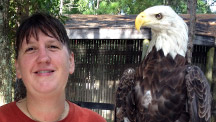A snowy owl has been spotted in California. Bird watchers noticed the bird on a road near Davis late last week. Snowy owls summer in Canada and migrate south for the winter. But their migration rarely brings them so far as Washington state or Oregon, let alone California. The last reported snowy sighting in California was in 1978. Read Crystal Ross O’Hara’s story in The Davis Enterprise.
Talking Parrot Reveals Girlfriend’s Affair
A talking parrot’s repeated mentioning of another man’s name wasn’t enough to arouse any suspicion in his owner. But when the parrot, named Ziggy, cried out “I love you, Gary”, Chris Taylor knew something was up. Read Paul Stokes story in the Telegraph.
Canada Goose Problem in New York’s Central Park
New York’s Central Park has a resident Canada goose population of more than 300, up from 20-30 just five years ago. The flock congregates around the Harlem Meer in the park’s northeast corner. As each individual produces 1-3 pounds of feces per day, the park is starting to have a goose-poop problem. Read more of Clem Richardson’s story at the New York Daily News.

Goose Family by edenpictures, Creative Commons on Flickr
Transvestite Bird With Homosexual Behavior Discovered
In an article to be published in the scientific journal Biology Letters, two Dutch experts claim to have discovered a bird species with three different types of male manifestations. The newly identified third type of male ruff (Philomachus pugnax) differs from others genetically as well as behaviorally. The discovery was made by bird expert Joop Jukema, who co-wrote the Biology Letters article with Theunis Piersma of the Rijksuniversiteit Groningen.
The ruff, a type of sandpiper, has been nearly wiped out of the Netherlands as a resident bird due to an inability to compete with modern farming methods. In the spring and fall, however, the birds are found in the Netherlands in great numbers as they migrate between their winter homes in western Africa to their summer residences in Scandinavia and Siberia.
Known as kemphanen in Dutch, the ruff was already known to have two types of male examples. The initial discovery was made fifty years ago by the Rijksuniversiteit Groningen. One male type was the “baseman”, who would defend a small territory against other basemen. The other type was the “satellite”, which defends no area but lives among and is tolerated by the basemen. The satellites are recognized by their white crown and collar. Basemen come in different color combinations.
Female ruffs, who are uniformly brown in color with no distinguishing markings, choose their mating partners, and they may choose one or more in a season. Basemen and satellites are equally popular among females.
The newly-discovered third male type is much smaller than basemen and satellites, but larger than females. It wears an inconspicuous brown coloring without any distinguishable crown or collar. And they only make up 1-2% of the population. Until their discovery, they were assumed to be females. The discoverers have named the type “faren”, an old Frisian word for patriarch, because they suspect that the birds may embody the original male of the species.
The faren not only resemble females, but also in some ways behave like them. In fact, they show interest in the basemen and frequently mate with them. Only one time has one been observed mating with a female. The experts speculate that the faren mate with the females secretly.
Since the testicles of the faren are at times larger than those of the basemen, researches speculate that the faren mate with the basemen and satellites in order to increase the basemen and satellites’ sperm count during the mating season.
Source: Travestieten met homoseksueel gedrag ontdekt bij kemphaan Transvestite with homosexual behavior discovered in the ruff
Murder Most Fowl
“Scientists announced on Thursday they had definitive proof that the ‘Taung child‘, a 2-million year old apeman skull famed as one of the most dramatic human evolutionary finds, was killed and eaten by an eagle.”
Poisoned Eagle Rescued In New York
A lead-poisoned eagle is brought back to health with compassion, teamwork and luck in Jeffersonville, New York.
Eviction Notice For Feeding Pigeons
A Bellingham, UK woman is threatened with eviction after ignoring warnings to stop feeding hundreds of pigeons in her back yard.
Farming Methods Threaten 29 Ireland Bird Species
“Many of [Ireland’s] birds are under threat because of trends in agriculture. 29 species of birds are in serious decline because of the introduction of more intensive farming methods that damage their habitat. Other wildlife, such as the marsh fritillary butterfly and 120 species of flowering plants, is also under threat.”
Red Kites Return To London Skies
“A rare bird of prey has been spotted in a garden in east London. Experts hope the sighting of a red kite in Hackney is proof the species is making a comeback to an area it thrived in during medieval times.”
Detroit Penguins To Undergo Cataract Surgery
Three penguins at the Detroit Zoo will undergo surgery Wednesday morning to remove cataracts which have impaired their vision.



